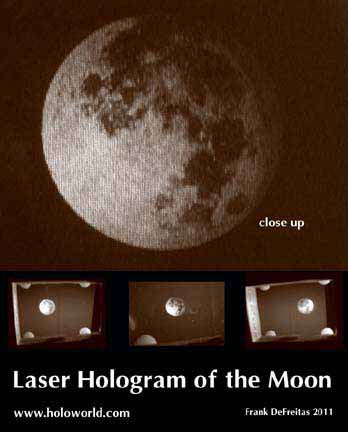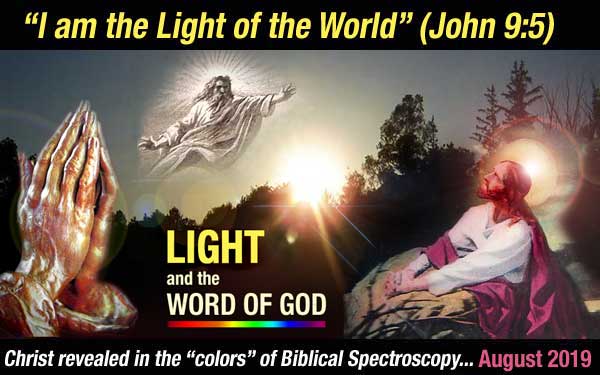
PODCAST: Preserving the Holy Word of God in Space: Part One
Lecture Count (total):
You may also: Download the MP3 File (16 MB / 16 minutes)
More Podcasts, photos and resources: CLICK HERE
Hologram of the Moon


** The Hologram Moon Was A Blue-Ribbon Winner,
New York Hall of Science, 2011 **
During my preparation for this holographic recording, it dawned on me that I might perhaps tap into some history along the way: to combine both the antiquarian with the contemporary. My research and inquiries led me to a wonderful candidate: a 19th century albumen stereoview card of the full moon by Prof. Henry Draper, of Hastings-on-Hudson, New York. A photo of the card, now in the Antiquarian Holographica collection, is shown below:

My ultimate goal, should my calculations prove correct, will be to combine one of Draper's full-moon left or right images, with one of my own full-moon left or right images. With these two images to work with, I could combine them into one definitive three-dimensional laser hologram.
So I am now prepping for the next full moon which takes place on March 19th. Of course, the images recorded will have to correctly fit in with one of Draper's images from the 1800's. For reasons that shall be explained in greater detail, there has to be several months difference in time between one exposure and the next.
Regardless of the content and method chosen (with various combinations available), this will be a long process. For instance, as of today, I have another month to wait for another opportunity for full-moon photography. And, keep in mind, that is weather permitting. A cloudy, rainy night during full moon phase will require another month of waiting yet again. If I miss the correct moon position due to bad weather, it could be as long as one year of waiting for another opportunity.
LIBRATION
Making a 3D photo of the moon is covered in many places online, so I will not go into detail here. In your travels online, you will come across a term -- "libration" -- given for the reason that it is possible to create a 3D moon photograph. For holographers, lunar libration can be thought of as the rotating table in recording a multiplex hologram, where the earth is stationary (the camera), and the object is rotating (the moon). In this particular case, the moon actually wobbles, as can be seen in this photo below showing Mare Crisium, and how its distance changes relative to the visble edge of the lunar surface.

I would recommend also that the student have an understanding of the barycenter concept: where the moon revolves around a point NEAR the center of the Earth, but not the center of the Earth itself. I believe, but not certain, that this also helps give the necessary separation of images for stereoscopic recording, which if my calculations are correct, should work out to be approx. 2,000 miles between the left and right eye views. This essentially would require a camera-on-rail type system, although on a planetary scale. Therefore I propose that one should also consider the stereoscopic effect of the off-centeredness of the orbit around the barycenter, rather than the physical "wobble" of the moon itself.

For this installment, here are the left and right eye views from Prof. Draper's stereoview card of the full moon. Once again, notice the shift in the position of Mare Crisium, and the distance between the two. If I were to match a full-moon image to the left eye photo of Prof. Draper, for best effect my own full-moon should match the right eye view (and vice versa). This is what I will be looking for in my photos.


MATCHING THE NEW WITH THE OLD
If calculations were correct, it was all a matter of luck. The images from Prof. Henry Draper were already taken, all I had to do was take one *new* successful moon photograph with my own telescope, and merge it with one of his *old* ones. Supposedly, several months have to pass between two images in order for them to successfully merge into a 3-dimensional image. Fortunately, since Henry Draper had two images on his stereoview card, I just needed to match either one with my own shot. If my shot didn't match one, it might match the other. Its also possible that the photo may not have been a good match with either.

The above photo shows (LEFT): Henry Draper's 1860's *right-eye* full-moon photo from his stereoview card. (RIGHT): My own full-moon photo from 19 March, 2011.

ABOVE: My photo became the new right-eye view to go with Draper's left-eye view. If you are able to view parallel stereoviews and get 3D, you'll do so with the above photo.
MAKING A 3D ANAGLYPH MOON PROOF
The next step in the process was to see how well the two images melded together. It could have been done by making several test holograms and correcting them, but a quicker and less time and cost-consuming method was to make a 3D anaglyph. If you have red/cyan 3D glasses, you will be able to see the sphere of the moon in 3D (below). Please view with the red filter over the left eye, and the cyan filter over the right eye. Polarized 3D glasses will not work, fyi.

The above photo shows a 3D anaglyph of the moon.
Red-cyan 3D glasses are needed to view it in 3D.
This method also gives me the liberty of adjusting registration between the two images, since only one photo at a time will be imaged by the hologram recording process. I have to make certain that they are both located within their correct and respective locations within the photo. Too far left or right and the entire 3D process will be at risk. Too far up or down and it will ruin the shot.
A STEREOVIEW CARD OF TWO VERY DIFFERENT MOONS
In my quest to create a three-dimensional hologram of the moon, I have made this 3D stereoview card showing both old (1860's) and new (2011) images of the full moon. They both combine to display a round sphere when viewed in a stereoscope. As with all of the previous work in this project, the left eye image is from Prof. Henry Draper, taken at his private observatory located in Hastings-on-Hudson. The right eye image is from myself, taken through my own telescope of the 19 March 2011 "super moon" @ Allentown, Pennsylvania (Allentown is southwest of New York City and northwest of Philadelphia).
These are the exact images that will be used with the hologram.

My "antique" 3D stereograph of the moon.
One hundred and fifty years have passed between one image and the other. Yet the moon remains as it was the night it was first recorded. It is fascinating that two images taken so far apart in time, can be brought together again to form one three-dimensional, round sphere in space. In one image, man was only dreaming of walking on the moon; in the other man had not only walked on the moon, but driven around its surface, hit golf balls, and taken Holy Communion. Two very different worlds fused into one three-dimensional image.
HOLOGRAPHIC RECORDING SYSTEM
For the end of April, I have set up my holographic recording system to capture a three-dimensional hologram of the moon (using stereo pair images). In the future, the moon will be recorded using multiple perspectives, but for now I am focusing on creating a simple laser transmission hologram. Also, if you wish to know more about the set-up, it is very similar to my hologram portrait system, except for exchanging people perspectives with moon perspectives. The biggest changes have been made on the front-end: the recording of the images to begin with, from both capturing to determining multiple perspectives.<
I will probably shoot this hologram in early May. Since this is a personal project, other holo obligations must come first. If all goes as planned, I hope to have this hologram of the moon on display at the New York Hall of Science in Fall 2011, for the Maker Faire. Stop by my table and see a three-dimensional round sphere of the moon float in space before your eyes. I hope to construct a viewing station, along with a star-filled backdrop. But, for now, first things first. Stay tuned for more updates as the spring and summer progresses.

Update 4/30/11: Last night I completed the cutting of the laser transmission hologram slits. With this particular piece, it was rather easy having only two views to store on the holographic plate. With future versions, many slits will have to be cut. I prefer to cut these by hand using 'traditional' graphic arts tools: ruler, t-square, and x-acto knife. Today, some prefer to move the slits mechanically via computer-controlled automation in real time. Slits are not needed for direct-object holograms, but are needed for this type of 3D hologram which is made from multiple 2D images.

THE HOLOGRAM OF THE MOON
As the photo shows, the hologram of the moon is now completed as of 2 May 2011. It was shot onto a Harman HoloFX holographic glass plate, using a HeNe laser and LCD panel for image generation. It is difficult to properly photograph a laser transmission hologram (the laser light saturates the camera sensor), so the actual image, in person, looks better and has more detail than the photo here shows:

THE HOLOGRAM MOON POSTER
The above photo shows a poster that I have created for the Hologram of the Moon project. It is a graphical celebration of creating the most unique image of the full moon in the world.
If you would like one of the hologram of the moon posters, you can download one to print out:
Here is your FREE Hologram of the Moon Poster(s), both sizes are suitable for printing and framing:
Download Moon Poster (8 x 10-inch)
Download Moon Poster (16 x 20-inch)
PUBLIC UNVEILING
Entry: 19 September 2011
The hologram of the moon was unveiled to the public for the first time at the New York Hall of Science on September 18th & 19th, 2011 (the first private viewing was at one of my summer holography workshop classes at the Smithsonian in Washington, D.C.). This was during the Maker Faire event, sponsored by Make Magazine. The display, which also included 3D technologies going back to the 19th century, won an Editor's Choice blue ribbon. It was well received, along with its companion stereoview card, shown in an antique stereoscope.
And thus concludes the making of the Hologram of the Moon.
Sincerely,
-- Frank DeFreitas





